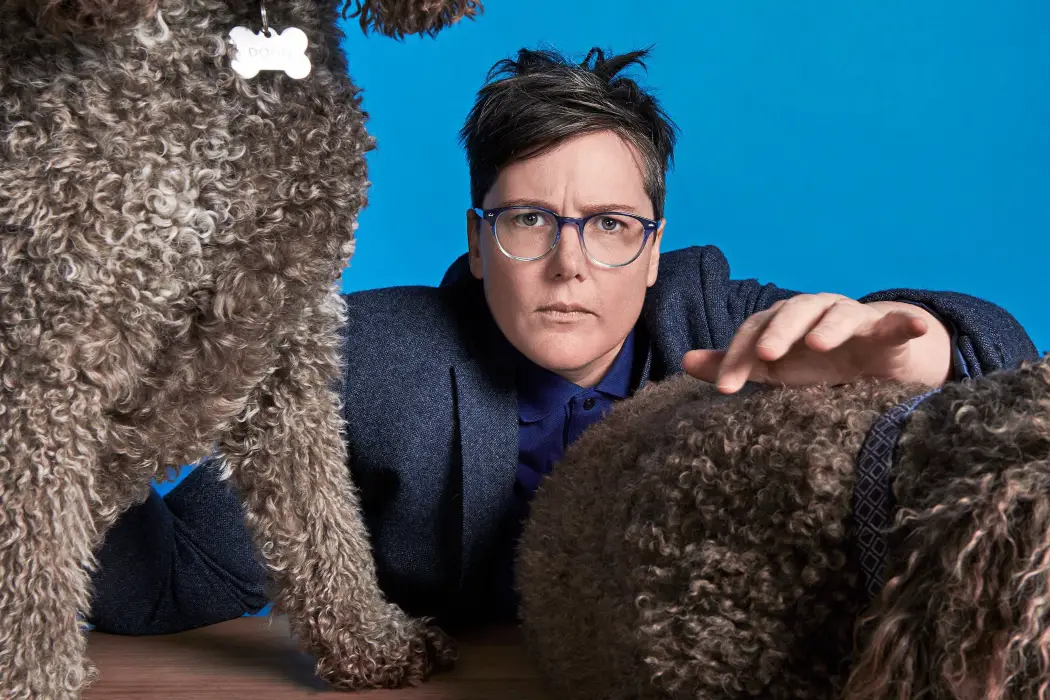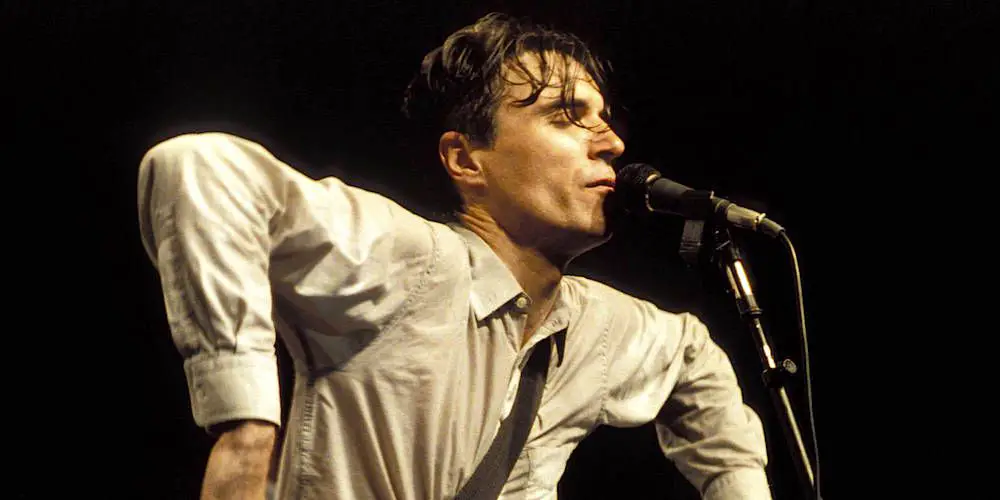Hannah Gadsby’s DOUGLAS Is A Masterpiece, But How Will It Fare On Film?

Hannah Gadsby’s Nanette is a stunning work — of comedy, of anti-comedy, of identity reaffirmation and public exorcising of demons. For all the people who say, “Throw it all away and start over,” Gadsby is one of the few who actually did it, or at least attempted to, in a mainstream setting. It’s a work of solidarity for those who have been hurt, those who see their trauma reflected in every aspect of the culture around them. And it’s also a stand-up routine, translated into a uniquely cinematic special by directors Madeleine Parry and Jon Olb, that sticks mostly to a normal stand-up format for the first half before exploding in a tension-filled climax.
In her latest show Douglas, Gadsby acknowledges her Netflix special’s success early on, noting — after the audience erupts into applause at the very mention of Nanette — that most people are here because of it. Then she says, “If I’d known how profitable trauma was, I would have spaced it out a little.”
Douglas is a different kind of show for Gadsby, one that more closely fits the tone and structure of a traditional stand-up show while still never shying away from confronting what’s happening around her. She admits that Nanette came about due to her boredom at trying to adhere to expectations of what comedy is, and further admits that Douglas came from her boredom at the thought of creating another Nanette.

Topics include body image (“Don’t go on a diet. Get a tailor.”), the white men who decide what’s important (“Blame the canon.”), and the fetishization of trauma that the response to Nanette represents (“Grief is not a train. Get off.”). It was the best stand-up show I — someone who’s seen Patton Oswalt, John Mulaney, Cameron Esposito, and Eugene Mirman — have ever been to. But as I was leaving the theater, the question on my mind was, How will this look on Netflix? Assuming it gets released as a special, will it match Nanette’s cinematic qualities? And what is the difference between a concert film and a concert film?
Theater vs. Film
While it’s debatable whether they truly count as concert films, the serpentine dance films of the 1890s certainly belong in the conversation. Filmed by everyone from the Lumières to Alice Guy-Blaché, these films may not be cinematic in the way we understand the concept now — they’re short one-shot recordings of dance routines. But the pure beauty of the dances and the graceful movement of the dancers make the films stand out as forward-thinking and important in the evolution of the art-form before Georges Méliès and Edwin Porter reworked the template completely.
Alfred Hitchc*ck’s 1948 masterpiece Rope is an early film that embodies the differences between theater and cinema, and was formulative in teaching me those differences when I stumbled upon it on TCM at age 12. It doesn’t seem like Rope should be all that distinctive as a film. It’s an adaptation of a play, made to appear as one single shot. But it represents the camera’s ability to do what our eyes can’t — to follow, to zoom, to zero in on exactly what you should be looking at, all with intent from the director themselves. In a theatrical production, your eye can wander, but in Rope, Hitchc*ck is always in control of where you’re looking, and he draws as much suspense from that control as he can.
The Art of the Filmed Performance
While many filmmakers were integral in figuring out how to shoot a musical performance — notably Gjon Mili, whose jazz shorts Jammin’ the Blues and Improvisation captured the collectiveness of performance decades before Jonathan Demme—the rock era is where the concert film blossomed. Monterey Pop (1968, D.A. Pennebaker), Woodstock (1970, Michael Wadleigh), and Gimme Shelter (1970, Albert Maysles/David Maysles/Charlotte Zwerin) document festivals and repackage them in a way that’s fit for a movie theater.
Of these three milestones, Gimme Shelter (which covers the disastrous Altamont Free Concert) is the most praised and the least essential, too fixated on The Rolling Stones’ own celebrity to pay the necessary mind to what’s happening offstage. Monterey Pop and Woodstock are much more collaborative, focusing on the organizers and audience as well as the performers. Woodstock is particularly fascinating. Watching it earlier this year, it played as a sort of antithesis to Netflix and Hulu’s non-concert films about Fyre Festival — documenting a time where everything went so well that even the music of Canned Heat and Crosby, Stills and Nash couldn’t ruin it.

Of course, the apex of the concert film is Jonathan Demme’s Stop Making Sense – which covers four nights of shows from Talking Heads, fresh off their 1983 hit album Speaking in Tongues — and brilliant though it is, its prominence has become rather annoying. Demme is no doubt a master at capturing a musical performance’s many facets, mainly by resisting the urge to focus only on the stars. Instead, everyone from the horn section to the backup singers and dancers gets a fair amount of screen time, and this led to artistic successes beyond Stop Making Sense. His subtle video for New Order’s “The Perfect Kiss” is an all-timer, and his Justin Timberlake + the Tennessee Kids achieved the impossible by making 20/20 Experience-era Justin Timberlake seem interesting.
His brilliance in the format is often overstated, however. Critic David Ehrlich, for example, tweeted during Beyoncé’s instant-classic Coachella performance, “impossible to watch Beyonce’s incredible Coachella set without thinking about what Jonathan Demme could have done with this.” People could, as a matter of fact, especially after Beyoncé documented the performance herself in this year’s Homecoming, which owes a larger debt to Prince’s Sign ‘o’ the Times than Stop Making Sense.
We can talk about a film without mentioning Citizen Kane, and we can talk about a band without mentioning The Beatles. An artform isn’t defined by its most successful or most beloved export, but any discussion about a concert film will inevitably bring up Demme, and it’s gotten quite limiting. And since I’ve spent multiple paragraphs in the middle of my Hannah Gadsby piece talking about the man, I’ll jot myself down as part of the problem and move on.
Comedy Specials
If there’s a comedy equivalent to Stop Making Sense, it’s got to be Jeff Margolis’ Richard Pryor: Live in Concert, the first and best stand-up film to get a theatrical release. It captures Richard Pryor at his peak, but one can’t deny Margolis’ role in the film’s success. Compare it to Pryor’s other specials — Live and Smokin’ (1971, Michael Blum), Live on the Sunset Strip (1982, Joe Layton), and Here and Now (1983, Richard Pryor) — and it becomes clear that it’s not just the material that makes Live in Concert the best of the bunch. It’s the energy and the way the camera captures said energy that makes it not just a convenient way to see a comedy performance without paying full price, but a great film.

Eddie Murphy’s 1983 HBO special Delirious is the same sort of case. Murphy’s stand-up in the 1980s is now famous for material that has not aged well at all, homophobic and misogynistic jokes galore. But Delirious is also famous for Murphy’s unadulterated energy, and it’s because of this that it remains so entertaining, even if one finds oneself grimacing more than laughing. It’s certainly more watchable than Raw, the theatrically-released follow-up that now reads more like the ravings of an angry woman-and-gay-basher than a work of comedy. Raw isn’t just worse because the material is lesser (though it is), but because both Murphy and director Robert Townsend fail to bring the same fire. If there’s a reason why people are excited that Murphy is returning to stand-up, it’s almost certainly Delirious, and not Raw.
Nanette & Douglas
Since the days of Pryor and Murphy, recorded stand-up has gotten formulaic. Shows like Comedy Central Presents and HBO’s One Night Stand pumped out half-hour specials for years, and suddenly the word special didn’t describe them at all. The popularity and mass-production of these shows was good for both comedians and fans of stand-up, but it’s been at the expense of any cinematic ambition. Nowadays, with Netflix releasing comedy specials monthly, the amount of shows with noteworthy camerawork or editing is close to nonexistent.
That’s why Nanette stood out so much when I first saw it. It wasn’t just the power of Gadsby’s writing and performance, but the way the camera assisted the material and vice-versa. Audience shots are kept to a minimum, and in the climax, the camera stays on Gadsby’s face for over three minutes — almost a Béla Tarr shot for a comedy show — and what she’s saying sticks with you all the more because of it.
When I re-watched Nanette recently, what it reminded me of most was Orson Welles’ F for Fake. This is partly because they both involve Pablo Picasso — with Welles creating new myths about Piccaso and Gadsby destroyed already-existing ones — but it’s more than that. Rather, it’s the way they each utilize the documentary format to their advantage, the way they play off of audience expectations, and the way they manipulate those expectations, telling you immediately what’s going to happen and still leaving you feeling whiplashed when it happens.
But the question remains: if/when Douglas is released as a special, will it be as cinematic as its predecessor? Short answer: I don’t think so. As a performance, it’s almost as powerful, but Gadsby actively resists the temptation to repeat herself. Nanette was never going to be a typical special, because it’s not a typical set. It necessitates as little camera movement as possible, and could easily be a one-shot like Rope or the old serpentine dance films. The majority of Douglas, on the other hand, could be shot like a Comedy Central production: joke, audience reaction, joke, audience reaction.
But there are also amazing moments of power, like when Gadsby discusses being diagnosed as autistic and an ableist wrong number text from her ex that ended the relationship. She doesn’t stick with the moment long, but it’s hard to see it shot in any typical way. It’s also hard to see it shot exactly like Nanette, and that’s what makes Gadsby so important — her work evolves, and the camera evolves with her. Nanette is fresh and emotionally potent as a film because the material needs it to be, and even if Douglas doesn’t match it, the material is strong enough that it could still wind up being the second greatest stand-up film of all time.
What are some other stand-up or concert films that you believe excel as works of cinema? Let us know in the comments below!
Does content like this matter to you?
Become a Member and support film journalism. Unlock access to all of Film Inquiry`s great articles. Join a community of like-minded readers who are passionate about cinema - get access to our private members Network, give back to independent filmmakers, and more.













